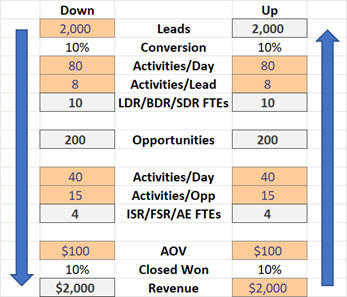Are you looking to determine how much revenue you’ll generate from your marketing and prospecting efforts? Or are you looking to determine how many leads and prospects you’ll need to achieve your revenue goals? These two numbers are opposite sides of the same coin – they are either the input or the output of the same equation. On the one hand, if you know the number of leads you will generate, you can forecast revenue based on historical conversion rates. On the other hand, if you know your revenue goal, you can calculate the number of leads you’ll need based on those same conversion rates.
While the formulas needed to make these calculations are rather straight forward, what really matters is will you have the resources needed to progress leads to opportunity and onto closed won sales. A lot depends on your sales process: how many touches, conversion ratios, average order value, length of sales cycle, and overcoming obstacles and objections all along the way by your lead generation team in concert with your sales team.
If you’re in charge of Sales, you’re likely looking in the rear-view mirror to calculate how many leads and prospects you’ll need to pull through your company’s sales process to achieve your forecasted closed won sales. If you’re heading up Marketing, you’re likely looking out the windshield to calculated how much closed won revenue you’ll generate from the leads and prospects you push into your company’s sales process. It can feel like a taffy pull but the outcome is more like that of a Christmas Cracker.
Marketing wants to forecast closed won sales from leads generated while Sales wants to work from a revenue goal and forecast pipeline coverage needed to achieve their target.
In my opinion it all sounds messy but accurately describes the conundrum between lead generation and sales forecasting. The missing piece of the puzzle between these two forecasts are the resources required, i.e., the workforce needed for prospecting and sales and the activity level they’ll need to conduct.

The Taffy Pull: Lead Gen Driving Sales – Sales Driving Lead Gen
Why start with the lead volume? If you’re the heading up Marketing, you’re going to want to start with lead volume and work forward to build a top-down model. If you’ve set out to create an aggressive marketing campaign and you’re optimistic that it will generate 1,000 inbound leads per month or 12,000 leads per year, how many sales will you generate? Of course, until you initiate your campaign you won’t know exactly how many leads you’ll generate, but you should have a good idea from similar campaigns run in the past. If you generate the expected number of prospects, you think you will have enough lead flow for Sales to hit their revenue targets. Thus, calculating from the top down from Marketing’s perspective is the way to go.
Why start with the revenue goal? If you’re the Sales leader, you’re going to want to start with the revenue goal and work backwards to build a bottom-up model. If you’ve decided to set an aggressive revenue goal for the coming fiscal year of $10,000,000, how many prospects will you need to reach? Of course, until you initiate outreach, you know how much pipeline you’ll create, but you should have a good idea from similar efforts in the past. If you generate the expected number of opportunities, you think based on historical conversion rates you think you will close enough sales to hi your revenue targets. Thus, calculating from the bottom up from Sales’ perspective is the way to go.
Hence, the taffy pull and the perpetual push-pull between Sales and Marketing.
The Christmas Cracker: Capacity Planning
If you’re given a revenue target – $10,000,000 – how many leads will you need to generate from inbound marketing or outbound prospecting? If you’re given a lead generation number – 12,000 – how many sales will you close from inbound contacts or prospecting outreach?
To build a capacity plan, there are core conversion ratios you will need:
- Leads to Opportunities
- Opportunities to Closed Won
- Average Order Value
- Sales Cycle
When developing more complex models, there are additional conversion ratios that could be helpful:
- AQL-to-MQL
- MQL-to-SQL
- SQL-to-SAL
- SAL-to-Opportunity
- Qualification-to-Needs Analysis
- Needs Analysis-to-Proposal
- Proposal-to-Negotiation
- Negotiation-to-Close Won (and therefore Closed Lost)
The Prize Inside: People and Activity
Conversion rates are only part of the picture. You will want to know the average number of touches the lead gen team conducts before setting an appointment for sales. And, you’ll want to know the average number of steps the sales team goes through to achieve a closed won sale.
Will there be LDRs, BDRs, and SDRs conducting prospecting activity at every step of the way? In the lead gen funnel, there is outreach in the form of calls, emails, social connections. There are also inbound contacts, initial interactions, and follow-up activities.
There are also ISRs, FSRs, and AEs conducting sales activity from first appointment to closed won. In the sales funnel there are meetings, demos, proposals, i.e., configuration, pricing, and quotes (“CPQ”).
The prize inside is in knowing how many people you’ll need to conduct how much activity to progress prospects from the top of the lead gen funnel to the bottom of the sales funnel.
The Answer: Build A Model!
Assuming you achieve similar response and conversion rates based on your historical benchmarks, you can calculate the number of LDRs, BDRs, SDRs, ISRs, FSRs and AEs you’re likely to need to handle the flow of leads and the opportunities you need to create and ultimately close. Will you have the right number of people in the right roles to achieve your goals?
A capacity model allows you to plan and forecast either from the top down or bottom up, it really doesn’t matter as long as both Marketing and Sales provide inputs and agree to align to the middle. If Marketing is driving a top-down model, then Sales will need to commit to the forecasted revenue. If Sales is driving a bottom-up model, then Marketing will need to commit to the lead generation volume. To determine if Marketing and Sales are on the same page and have the same expectation, working the capacity plan forward and backwards should allow you to determine if these stakeholders achieve alignment.

In the simple model illustrated above, there are inputs for either the anticipated number of leads (upper left corner) or the revenue target (lower right corner). There are also inputs for the number of activities performed along with conversion rates and AOV. Combined we can determine the number of people (FTEs) required to conduct lead gen and sales activities. Based on the inputs, this example suggests 14 FTEs – 10 LDR/BDR/SDRs for lead gen activity and 4 ISR/FSR/AEs for sales activity. In a win team model where BDRs are paired with AEs, and a rough rule of thumb suggests a 2:1 ratio between BDRs and AEs. Without a model, you’ll find yourself guessing how many resources may be required.
Alignment: Did You Catch a Whiff of Garlic?
According to an article in The Guardian from May of 1994, the Channel Tunnel was out of alignment by just 30cm horizontally and only 8cm vertically. When the tunnel workers finally met in the middle they are quoted as saying “We can smell the whiff of garlic coming through the tunnel.”
Such alignment is a miracle. No not really, it was all due to planning and measurement. Much like the tunnel workers, Marketing and Sales hope that they are aligned and meet in the middle. You just won’t know until you start building a few models, testing some scenarios, examining the model output, and refining the inputs. Now this is where things get messy.
All models are wrong, but some are useful. George Box
The more nuanced the model is with complex calculations such as incorporating cascading ratios, the cleverer the capacity model becomes, but the more errors that can be introduced.
Once you’ve built a model, Microsoft Excel has a very cool What-If Analysis function called Goal Seek. It works by setting the value of one cell and letting Excel iterate through the computations by changing another the value in another cell until Excel finds a solution. It’s powerful and fun to watch as you can see the computations in real time.
So, What’s the Solution? A Feedback Loop Between Marketing and Sales
If you the head of Marketing, you’ll find it useful to forward engineer revenue goals based on your anticipated marketing campaigns. But if you are the Sales leader, you’ll want to back test your revenue targets to ensure you’ll generate enough opportunities and Marketing will be sending you enough leads. You’ll want to know where those leads are going to come from. And know how much marketing campaign coverage will be needed. And what level of prospecting will generate the outcomes you seek.
The conversion ratios at each step or stage as leads progress to closed won deals should be the same forward and backward. So, in theory the mathematics should work no matter which way you run the numbers. If both teams are working with the same conversion metrics, it’s likely that both top-down and bottom-up modeling will produce the same results. If they don’t, you’ll need to investigate further to uncover the reality.
Aspirational Targets versus Benchmark Results
When you build a model and the numbers don’t line up, what you’re likely uncovered is an aspirational target versus benchmarks and historical results. An aspirational target is a target often disguised as a stretch goal to inspire your team to be more ambitious and focus on the bigger picture. What you may have really uncovered is a management moon shot that is unattainable with the people, processes, systems, and data you have in place.
The capacity model can help you to triangulate on the answers:
- Do you have the necessary number of people with the right skills in the right roles?
- Do you have the processes in place to progress the prospects towards closed deals?
- Do you have the systems needed to support the people and the prospects?
- Do you have the data needed to manage, measure, and process the prospects?
Reconciliation: Plan v. Actuals
Once your efforts are underway, you will want to revisit your capacity model and reconcile with actual results. Did Marketing generate enough leads? Is Sales closing enough opportunities? Are the team(s) conducting enough activity? If reviewed frequently – for example, after the close of each month or quarter – you should be able to course correct.
The correction needed will depend on what has fallen out of synch. Were there fewer leads generated than expected? Were deals slower to close than anticipated? Were there external market forces that resulted in unexpected disruptions to your sales process? Did a competitor announce a new product and start gobbling up market share? Did you lose your star salesperson to another firm during the Great Resignation? If sales are declining, can you increase lead production? If conversion to opportunity is lower than expected, can you improve your market targeting?
If you can ascertain what happened, then you can determine what to do about it.
To Long; Didn’t Read (TL;DR)
Build a model, forecast leads and sales, align forecasts, tack actuals, compare results, and find variances, adjust as quickly as possible. Keep repeating.
If you think this process might work for you and you’d like to learn more, feel free to reach out to me.
About the Author
Stephen Howell is a multifaceted expert with a wealth of experience in technology, business management, and development. He is the innovative mind behind the cutting-edge AI powered Kognetiks Chatbot for WordPress plugin. Utilizing the robust capabilities of OpenAI’s API, this conversational chatbot can dramatically enhance your website’s user engagement. Visit Kognetiks Chatbot for WordPress to explore how to elevate your visitors’ experience, and stay connected with his latest advancements and offerings in the WordPress community.



Leave a Reply
You must be logged in to post a comment.